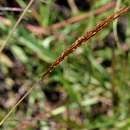Description
provided by Flora of Zimbabwe
Perennial grass, up to 1.5m tall, sometimes tufted but also mat-forming. Inflorescences and spikelets with rusty-brown or golden hairs.
- license
- cc-by-nc
- copyright
- Mark Hyde, Bart Wursten and Petra Ballings
- bibliographic citation
- Hyde, M.A., Wursten, B.T. and Ballings, P. (2002-2014). Eulalia aurea (Bory) Kunth Flora of Zimbabwe website. Accessed 28 August 2014 at http://www.zimbabweflora.co.zw/speciesdata/species.php?species_id=108210
- author
- Mark Hyde
- author
- Bart Wursten
- author
- Petra Ballings
Frequency
provided by Flora of Zimbabwe
Locally common
- license
- cc-by-nc
- copyright
- Mark Hyde, Bart Wursten and Petra Ballings
- bibliographic citation
- Hyde, M.A., Wursten, B.T. and Ballings, P. (2002-2014). Eulalia aurea (Bory) Kunth Flora of Zimbabwe website. Accessed 28 August 2014 at http://www.zimbabweflora.co.zw/speciesdata/species.php?species_id=108210
- author
- Mark Hyde
- author
- Bart Wursten
- author
- Petra Ballings
Worldwide distribution
provided by Flora of Zimbabwe
From E Africa southwards to S Africa; also Réunion and Australia
- license
- cc-by-nc
- copyright
- Mark Hyde, Bart Wursten and Petra Ballings
- bibliographic citation
- Hyde, M.A., Wursten, B.T. and Ballings, P. (2002-2014). Eulalia aurea (Bory) Kunth Flora of Zimbabwe website. Accessed 28 August 2014 at http://www.zimbabweflora.co.zw/speciesdata/species.php?species_id=108210
- author
- Mark Hyde
- author
- Bart Wursten
- author
- Petra Ballings
Eulalia aurea: Brief Summary
provided by wikipedia EN
Eulalia aurea is a grass (in the Poaceae family). It was first described as Andropogon aureum in 1804 by Bory de Saint-Vincent but was transferred to the genus, Eulalia, in 1830 by Kunth.
The Walmajarri people of the southern Kimberley call it "Water grass" and Jirtapuru.
- license
- cc-by-sa-3.0
- copyright
- Wikipedia authors and editors

